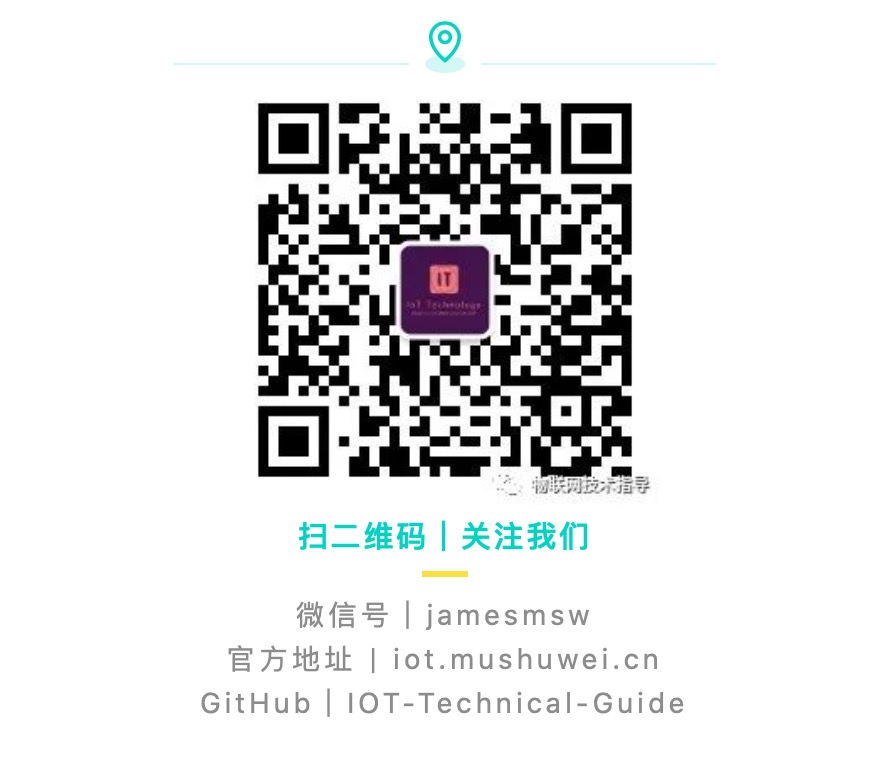前言

在本教程中,我们将开发一个Spring Boot应用程序,该应用程序使用JWT身份验证来保护公开的REST API。在此示例中,我们将使用硬编码的用户和密码进行用户身份验证。
在下一个教程中,我们将实现Spring Boot + JWT + MySQL JPA,用于存储和获取用户凭证。任何用户只有拥有有效的JSON Web Token(JWT)才能使用此API。在之前的教程中,我们学习了《什么是JWT?》 以及何时并如何使用它。
为了更好地理解,我们将分阶段开发此项目:
- 开发一个Spring Boot应用程序,该应用程序使用/hello路径地址公开一个简单的GET RESTAPI。
- 为JWT配置Spring Security, 暴露路径地址/authenticate POST RESTAPI。使用该映射,用户将获得有效的JSON Web Token。然后,仅在具有有效令牌的情况下,才允许用户访问API
/hello。
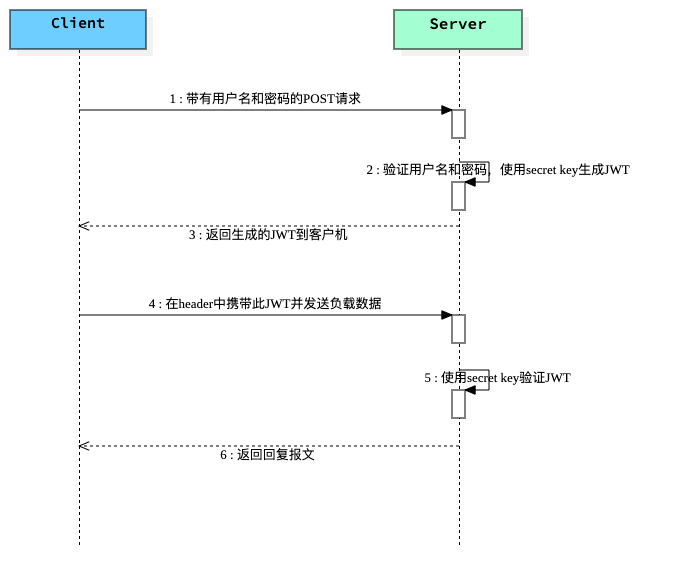
搭建SpringBoot应用程序
目录结构

Pom.xml
<dependencies>
<dependency>
<groupId>org.springframework.boot</groupId>
<artifactId>spring-boot-starter-web</artifactId>
</dependency>
</dependencies>
HelloWorld API
package iot.technology.jwt.without.controller;
import org.springframework.web.bind.annotation.CrossOrigin;
import org.springframework.web.bind.annotation.RequestMapping;
import org.springframework.web.bind.annotation.RestController;
/**
* @author james mu
* @date 2020/9/7 19:18
*/
@RestController
@CrossOrigin
public class HelloWorldController {
@RequestMapping({ "/hello" })
public String hello() {
return "Hello World";
}
}
创建bootstrap引导类
package iot.technology.jwt.without;
import org.springframework.boot.SpringApplication;
import org.springframework.boot.autoconfigure.SpringBootApplication;
/**
* @author james mu
* @date 2020/9/7 17:59
*/
@SpringBootApplication(scanBasePackages = {"iot.technology.jwt.without"})
public class JwtWithoutJpaApplication {
public static void main(String[] args) {
SpringApplication.run(JwtWithoutJpaApplication.class, args);
}
}
编译并将JwtWithoutJpaApplication.java作为Java应用程序运行。在网页输入localhost:8080/hello。
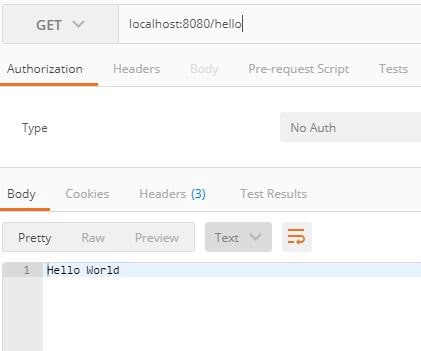
Spring Security和JWT配置
我们将配置Spring Security和JWT来执行两个操作
-
生成JWT---暴露/authenticate接口。传递正确的用户名和密码后,它将生成一个JSON Web Token(JWT)。
-
验证JWT---如果用户尝试使用接口/hello,仅当请求具有有效的JSON Web Token(JWT),它才允许访问。
目录结构

生成JWT时序图

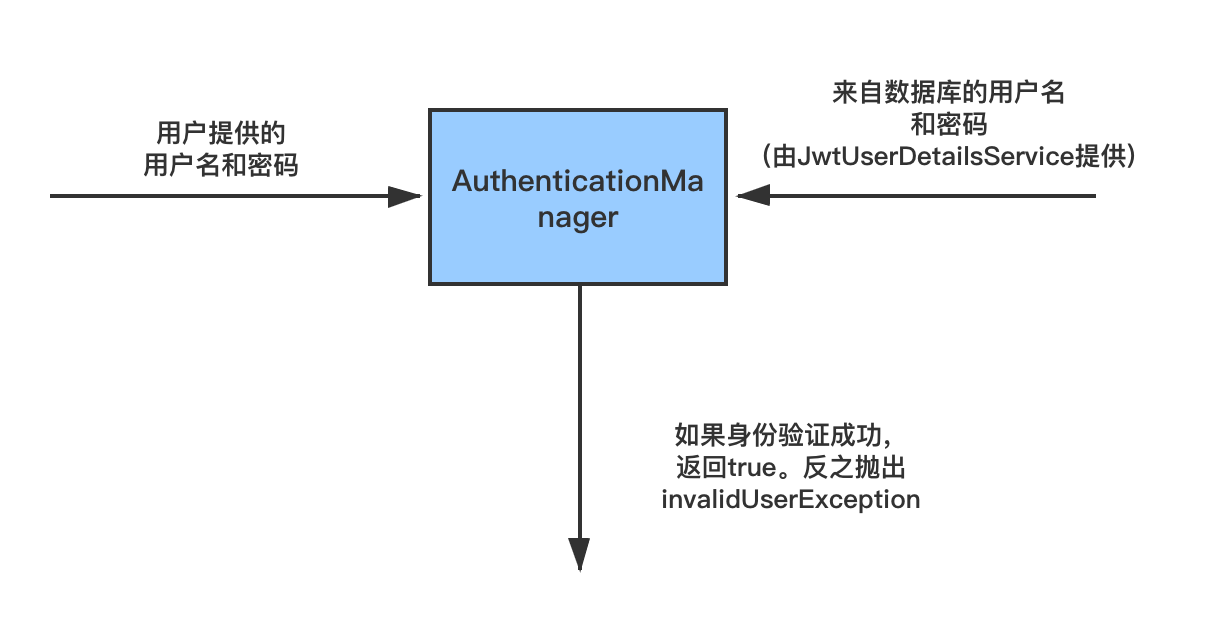
验证JWT时序图
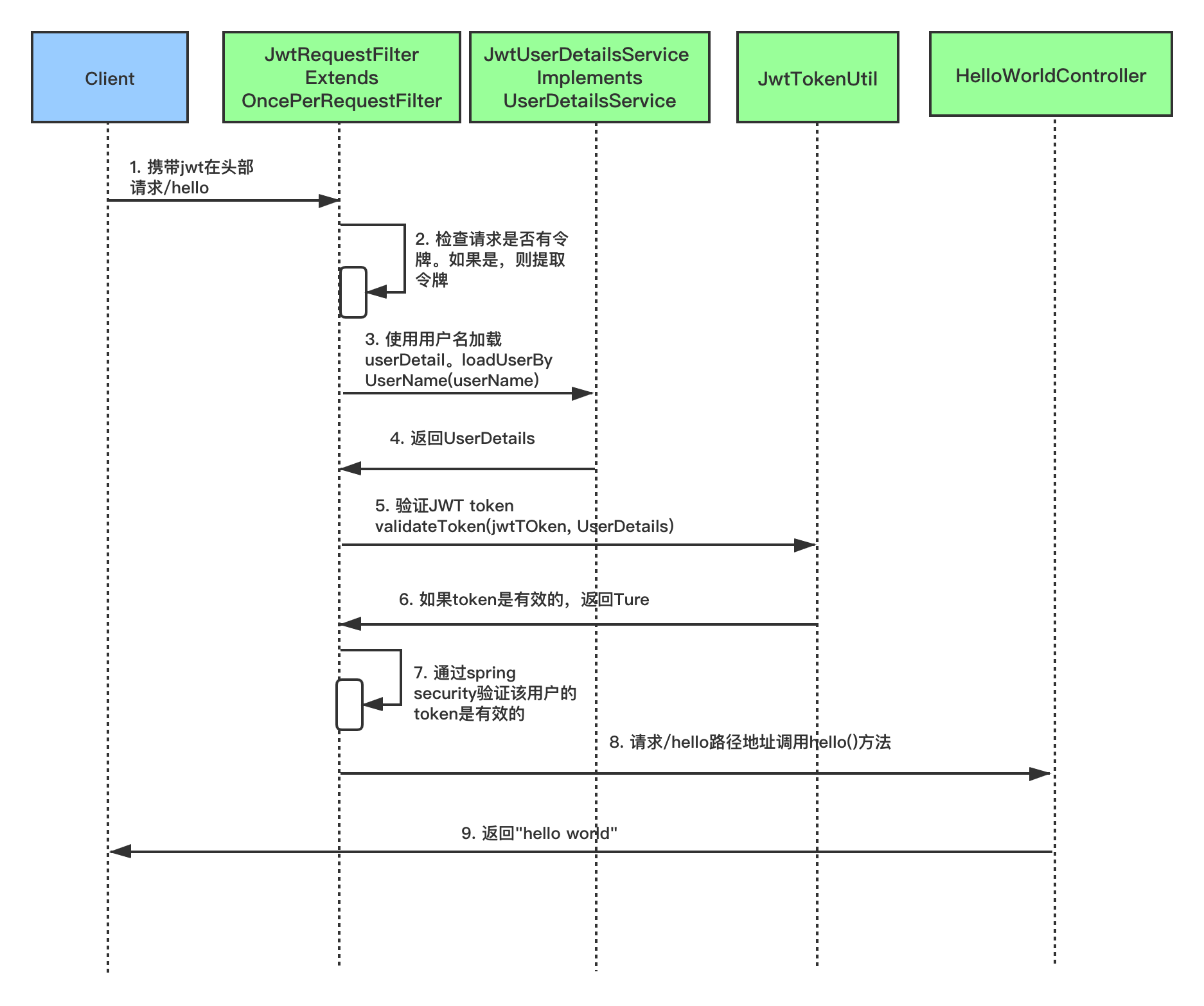
添加Spring Security和JWT依赖项
<dependency>
<groupId>org.springframework.boot</groupId>
<artifactId>spring-boot-starter-web</artifactId>
</dependency>
<dependency>
<groupId>org.springframework.boot</groupId>
<artifactId>spring-boot-starter-security</artifactId>
</dependency>
<dependency>
<groupId>io.jsonwebtoken</groupId>
<artifactId>jjwt</artifactId>
</dependency>
定义application.properties。正如在先前的JWT教程中所见,我们指定了用于哈希算法的密钥。密钥与标头和有效载荷结合在一起以创建唯一的哈希。如果您拥有密钥,我们只能验证此哈希。
jwt.secret=iot.technology
代码剖析
JwtTokenUtil
package iot.technology.jwt.without.config;
import io.jsonwebtoken.Claims;
import io.jsonwebtoken.Jwts;
import io.jsonwebtoken.SignatureAlgorithm;
import org.springframework.beans.factory.annotation.Value;
import org.springframework.security.core.userdetails.UserDetails;
import org.springframework.stereotype.Component;
import java.io.Serializable;
import java.util.Date;
import java.util.HashMap;
import java.util.Map;
import java.util.function.Function;
/**
* @author james mu
* @date 2020/9/7 19:12
*/
@Component
public class JwtTokenUtil implements Serializable {
private static final long serialVersionUID = -2550185165626007488L;
public static final long JWT_TOKEN_VALIDITY = 5*60*60;
@Value("${jwt.secret}")
private String secret;
public String getUsernameFromToken(String token) {
return getClaimFromToken(token, Claims::getSubject);
}
public Date getIssuedAtDateFromToken(String token) {
return getClaimFromToken(token, Claims::getIssuedAt);
}
public Date getExpirationDateFromToken(String token) {
return getClaimFromToken(token, Claims::getExpiration);
}
public <T> T getClaimFromToken(String token, Function<Claims, T> claimsResolver) {
final Claims claims = getAllClaimsFromToken(token);
return claimsResolver.apply(claims);
}
private Claims getAllClaimsFromToken(String token) {
return Jwts.parser().setSigningKey(secret).parseClaimsJws(token).getBody();
}
private Boolean isTokenExpired(String token) {
final Date expiration = getExpirationDateFromToken(token);
return expiration.before(new Date());
}
private Boolean ignoreTokenExpiration(String token) {
// here you specify tokens, for that the expiration is ignored
return false;
}
public String generateToken(UserDetails userDetails) {
Map<String, Object> claims = new HashMap<>();
return doGenerateToken(claims, userDetails.getUsername());
}
private String doGenerateToken(Map<String, Object> claims, String subject) {
return Jwts.builder().setClaims(claims).setSubject(subject).setIssuedAt(new Date(System.currentTimeMillis()))
.setExpiration(new Date(System.currentTimeMillis() + JWT_TOKEN_VALIDITY*1000)).signWith(SignatureAlgorithm.HS512, secret).compact();
}
public Boolean canTokenBeRefreshed(String token) {
return (!isTokenExpired(token) || ignoreTokenExpiration(token));
}
public Boolean validateToken(String token, UserDetails userDetails) {
final String username = getUsernameFromToken(token);
return (username.equals(userDetails.getUsername()) && !isTokenExpired(token));
}
}
JWTUserDetailsService
JWTUserDetailsService实现了Spring Security UserDetailsService接口。它会覆盖loadUserByUsername,以便使用用户名从数据库中获取用户详细信息。当对用户提供的用户详细信息进行身份验证时,Spring Security Authentication Manager调用此方法从数据库中获取用户详细信息。在这里,我们从硬编码的用户列表中获取用户详细信息。在接下来的教程中,我们将增加从数据库中获取用户详细信息的DAO实现。用户密码也使用BCrypt以加密格式存储。在这里,您可以使用在线Bcrypt生成器为密码生成Bcrypt。
package iot.technology.jwt.without.service;
import org.springframework.security.core.userdetails.User;
import org.springframework.security.core.userdetails.UserDetails;
import org.springframework.security.core.userdetails.UserDetailsService;
import org.springframework.security.core.userdetails.UsernameNotFoundException;
import org.springframework.stereotype.Service;
import java.util.ArrayList;
/**
* @author james mu
* @date 2020/9/7 18:16
*/
@Service
public class JwtUserDetailsService implements UserDetailsService {
@Override
public UserDetails loadUserByUsername(String username) throws UsernameNotFoundException {
if ("iot.technology".equals(username)) {
return new User("iot.technology", "$2a$10$slYQmyNdGzTn7ZLBXBChFOC9f6kFjAqPhccnP6DxlWXx2lPk1C3G6",
new ArrayList<>());
} else {
throw new UsernameNotFoundException("User not found with username: " + username);
}
}
}
JWTAuthenticationController
使用JwtAuthenticationController暴露/authenticate。使用Spring Authentication Manager验证用户名和密码。如果凭据有效,则会使用JWTTokenUtil创建一个JWT令牌并将其提供给客户端。
package iot.technology.jwt.without.controller;
import iot.technology.jwt.without.config.JwtTokenUtil;
import iot.technology.jwt.without.model.JwtRequest;
import iot.technology.jwt.without.model.JwtResponse;
import org.springframework.http.ResponseEntity;
import org.springframework.security.authentication.AuthenticationManager;
import org.springframework.security.authentication.BadCredentialsException;
import org.springframework.security.authentication.DisabledException;
import org.springframework.security.authentication.UsernamePasswordAuthenticationToken;
import org.springframework.security.core.userdetails.UserDetails;
import org.springframework.security.core.userdetails.UserDetailsService;
import org.springframework.web.bind.annotation.*;
import java.util.Objects;
/**
* @author james mu
* @date 2020/9/7 19:19
*/
@RestController
@CrossOrigin
public class JwtAuthenticationController {
private final AuthenticationManager authenticationManager;
private final JwtTokenUtil jwtTokenUtil;
private final UserDetailsService jwtInMemoryUserDetailsService;
public JwtAuthenticationController(AuthenticationManager authenticationManager,
JwtTokenUtil jwtTokenUtil,
UserDetailsService jwtInMemoryUserDetailsService) {
this.authenticationManager = authenticationManager;
this.jwtTokenUtil = jwtTokenUtil;
this.jwtInMemoryUserDetailsService = jwtInMemoryUserDetailsService;
}
@RequestMapping(value = "/authenticate", method = RequestMethod.POST)
public ResponseEntity<?> createAuthenticationToken(@RequestBody JwtRequest authenticationRequest)
throws Exception {
authenticate(authenticationRequest.getUsername(), authenticationRequest.getPassword());
final UserDetails userDetails = jwtInMemoryUserDetailsService
.loadUserByUsername(authenticationRequest.getUsername());
final String token = jwtTokenUtil.generateToken(userDetails);
return ResponseEntity.ok(new JwtResponse(token));
}
private void authenticate(String username, String password) throws Exception {
Objects.requireNonNull(username);
Objects.requireNonNull(password);
try {
authenticationManager.authenticate(new UsernamePasswordAuthenticationToken(username, password));
} catch (DisabledException e) {
throw new Exception("USER_DISABLED", e);
} catch (BadCredentialsException e) {
throw new Exception("INVALID_CREDENTIALS", e);
}
}
}
JwtRequest
JwtRequest是存储我们从客户端收到的用户名和密码所必须的类。
package iot.technology.jwt.without.model;
import java.io.Serializable;
/**
* @author james mu
* @date 2020/9/7 18:30
*/
public class JwtRequest implements Serializable {
private static final long serialVersionUID = 5926468583005150707L;
private String username;
private String password;
//need default constructor for JSON Parsing
public JwtRequest()
{
}
public JwtRequest(String username, String password) {
this.setUsername(username);
this.setPassword(password);
}
public String getUsername() {
return this.username;
}
public void setUsername(String username) {
this.username = username;
}
public String getPassword() {
return this.password;
}
public void setPassword(String password) {
this.password = password;
}
}
JwtResponse
这是创建包含要返回给用户的JWT响应所必须的类。
package iot.technology.jwt.without.model;
import java.io.Serializable;
/**
* @author james mu
* @date 2020/9/7 19:11
*/
public class JwtResponse implements Serializable {
private static final long serialVersionUID = -8091879091924046844L;
private final String jwttoken;
public JwtResponse(String jwttoken) {
this.jwttoken = jwttoken;
}
public String getToken() {
return this.jwttoken;
}
}
JwtRequestFilter
JwtRequestFilter继承了Spring Web的OncePerRequestFilter类。对于任何传入请求,都会执行此Filter类。它检查请求是否具有有效的JWT令牌。如果它具有有效的JWT令牌,则它将在上下文中设置Authentication,以指定当前用户已通过身份验证。
package iot.technology.jwt.without.config;
import io.jsonwebtoken.ExpiredJwtException;
import iot.technology.jwt.without.service.JwtUserDetailsService;
import lombok.extern.slf4j.Slf4j;
import org.springframework.security.authentication.UsernamePasswordAuthenticationToken;
import org.springframework.security.core.context.SecurityContextHolder;
import org.springframework.security.core.userdetails.UserDetails;
import org.springframework.security.web.authentication.WebAuthenticationDetailsSource;
import org.springframework.stereotype.Component;
import org.springframework.web.filter.OncePerRequestFilter;
import javax.servlet.FilterChain;
import javax.servlet.ServletException;
import javax.servlet.http.HttpServletRequest;
import javax.servlet.http.HttpServletResponse;
import java.io.IOException;
/**
* @author james mu
* @date 2020/9/7 19:14
*/
@Slf4j
@Component
public class JwtRequestFilter extends OncePerRequestFilter {
private final JwtUserDetailsService jwtUserDetailsService;
private final JwtTokenUtil jwtTokenUtil;
public JwtRequestFilter(JwtUserDetailsService jwtUserDetailsService, JwtTokenUtil jwtTokenUtil) {
this.jwtTokenUtil = jwtTokenUtil;
this.jwtUserDetailsService = jwtUserDetailsService;
}
@Override
protected void doFilterInternal(HttpServletRequest request, HttpServletResponse response, FilterChain chain)
throws ServletException, IOException {
final String requestTokenHeader = request.getHeader("Authorization");
String username = null;
String jwtToken = null;
// JWT Token is in the form "Bearer token". Remove Bearer word and get only the Token
if (requestTokenHeader != null && requestTokenHeader.startsWith("Bearer ")) {
jwtToken = requestTokenHeader.substring(7);
try {
username = jwtTokenUtil.getUsernameFromToken(jwtToken);
} catch (IllegalArgumentException e) {
log.error("Unable to get JWT Token");
} catch (ExpiredJwtException e) {
log.error("JWT Token has expired");
}
} else {
logger.warn("JWT Token does not begin with Bearer String");
}
//Once we get the token validate it.
if (username != null && SecurityContextHolder.getContext().getAuthentication() == null) {
UserDetails userDetails = this.jwtUserDetailsService.loadUserByUsername(username);
// if token is valid configure Spring Security to manually set authentication
if (jwtTokenUtil.validateToken(jwtToken, userDetails)) {
UsernamePasswordAuthenticationToken usernamePasswordAuthenticationToken = new UsernamePasswordAuthenticationToken(
userDetails, null, userDetails.getAuthorities());
usernamePasswordAuthenticationToken
.setDetails(new WebAuthenticationDetailsSource().buildDetails(request));
// After setting the Authentication in the context, we specify
// that the current user is authenticated. So it passes the Spring Security Configurations successfully.
SecurityContextHolder.getContext().setAuthentication(usernamePasswordAuthenticationToken);
}
}
chain.doFilter(request, response);
}
}
JwtAuthenticationEntryPoint
此类继承Spring Security的AuthenticationEntryPoint类,并重写其commence。它拒绝每个未经身份验证的请求并发送错误代码401。
package iot.technology.jwt.without.config;
import org.springframework.security.core.AuthenticationException;
import org.springframework.security.web.AuthenticationEntryPoint;
import org.springframework.stereotype.Component;
import javax.servlet.http.HttpServletRequest;
import javax.servlet.http.HttpServletResponse;
import java.io.IOException;
import java.io.Serializable;
/**
* @author james mu
* @date 2020/9/7 19:17
*/
@Component
public class JwtAuthenticationEntryPoint implements AuthenticationEntryPoint, Serializable {
private static final long serialVersionUID = -7858869558953243875L;
@Override
public void commence(HttpServletRequest request, HttpServletResponse response,
AuthenticationException authException) throws IOException {
response.sendError(HttpServletResponse.SC_UNAUTHORIZED, "Unauthorized");
}
}
WebSecurityConfig
此类扩展了WebSecurityConfigurerAdapter,它为WebSecurity和HttpSecurity进行自定义提供了便捷性。
package iot.technology.jwt.without.config;
import org.springframework.beans.factory.annotation.Autowired;
import org.springframework.context.annotation.Bean;
import org.springframework.context.annotation.Configuration;
import org.springframework.security.authentication.AuthenticationManager;
import org.springframework.security.config.annotation.authentication.builders.AuthenticationManagerBuilder;
import org.springframework.security.config.annotation.method.configuration.EnableGlobalMethodSecurity;
import org.springframework.security.config.annotation.web.builders.HttpSecurity;
import org.springframework.security.config.annotation.web.configuration.EnableWebSecurity;
import org.springframework.security.config.annotation.web.configuration.WebSecurityConfigurerAdapter;
import org.springframework.security.config.http.SessionCreationPolicy;
import org.springframework.security.core.userdetails.UserDetailsService;
import org.springframework.security.crypto.bcrypt.BCryptPasswordEncoder;
import org.springframework.security.crypto.password.PasswordEncoder;
import org.springframework.security.web.authentication.UsernamePasswordAuthenticationFilter;
/**
* @author james mu
* @date 2020/9/7 19:16
*/
@Configuration
@EnableWebSecurity
@EnableGlobalMethodSecurity(prePostEnabled = true)
public class WebSecurityConfig extends WebSecurityConfigurerAdapter {
private final JwtAuthenticationEntryPoint jwtAuthenticationEntryPoint;
private final UserDetailsService jwtUserDetailsService;
private final JwtRequestFilter jwtRequestFilter;
public WebSecurityConfig(JwtAuthenticationEntryPoint jwtAuthenticationEntryPoint,
UserDetailsService jwtUserDetailsService,
JwtRequestFilter jwtRequestFilter) {
this.jwtAuthenticationEntryPoint = jwtAuthenticationEntryPoint;
this.jwtUserDetailsService = jwtUserDetailsService;
this.jwtRequestFilter = jwtRequestFilter;
}
@Autowired
public void configureGlobal(AuthenticationManagerBuilder auth) throws Exception {
// configure AuthenticationManager so that it knows from where to load
// user for matching credentials
// Use BCryptPasswordEncoder
auth.userDetailsService(jwtUserDetailsService).passwordEncoder(passwordEncoder());
}
@Bean
public PasswordEncoder passwordEncoder() {
return new BCryptPasswordEncoder();
}
@Bean
@Override
public AuthenticationManager authenticationManagerBean() throws Exception {
return super.authenticationManagerBean();
}
@Override
protected void configure(HttpSecurity httpSecurity) throws Exception {
// We don't need CSRF for this example
httpSecurity.csrf().disable()
// dont authenticate this particular request
.authorizeRequests().antMatchers("/authenticate").permitAll().
// all other requests need to be authenticated
anyRequest().authenticated().and().
// make sure we use stateless session; session won't be used to
// store user's state.
exceptionHandling().authenticationEntryPoint(jwtAuthenticationEntryPoint).and().sessionManagement()
.sessionCreationPolicy(SessionCreationPolicy.STATELESS);
// Add a filter to validate the tokens with every request
httpSecurity.addFilterBefore(jwtRequestFilter, UsernamePasswordAuthenticationFilter.class);
}
}
代码演示
-
启动Spring Boot应用程序
-
生成JSON Web Token(JWT)
-
使用Url
localhost:8080/authenticate创建POST请求。正文应具有有效的用户名和密码。在我们的情况下,用户名是: iot.technology, 密码是: password。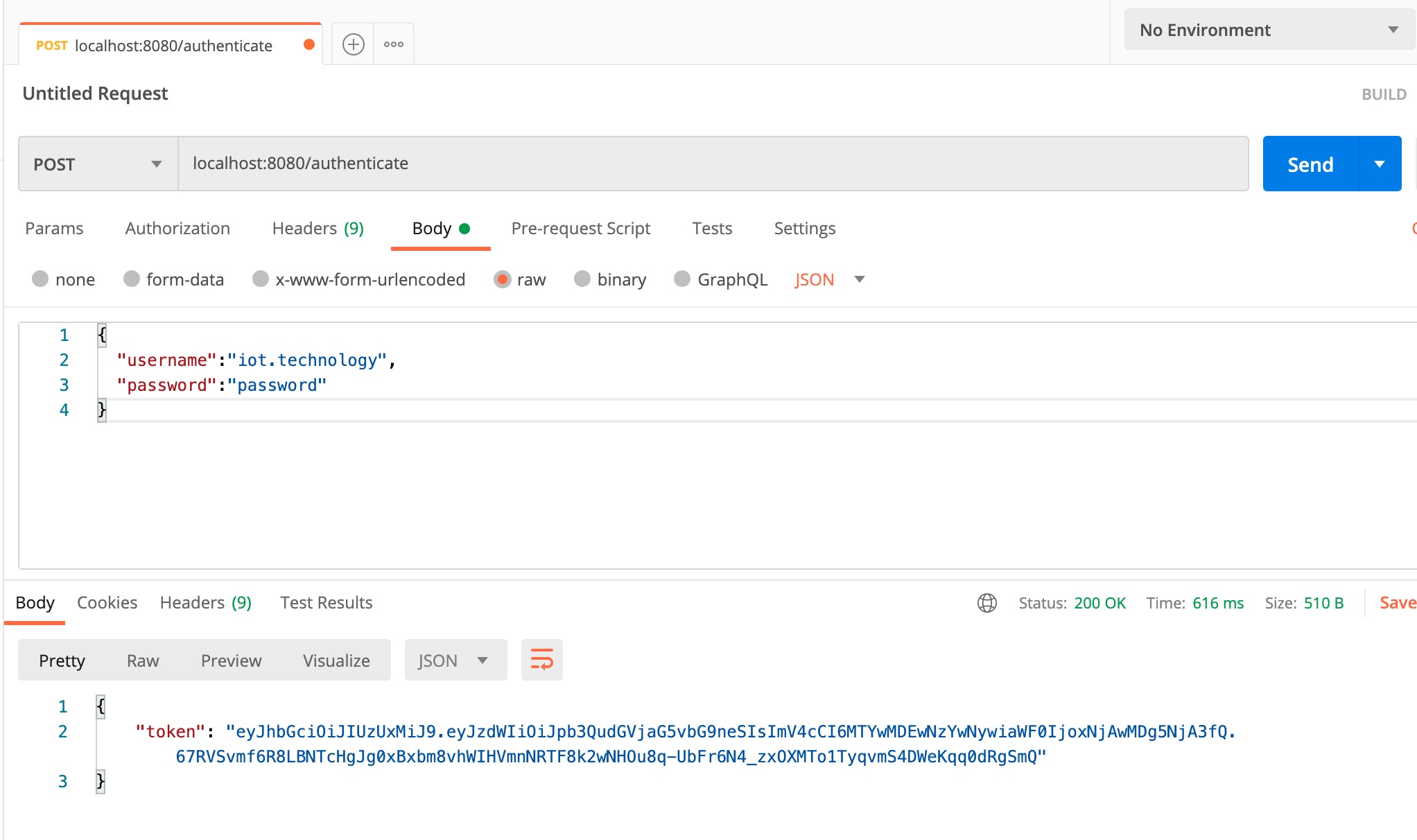
-
验证JSON Web Token(JWT)
-
尝试使用上述生成的令牌访问Url localhost:8080/hello,如下所示
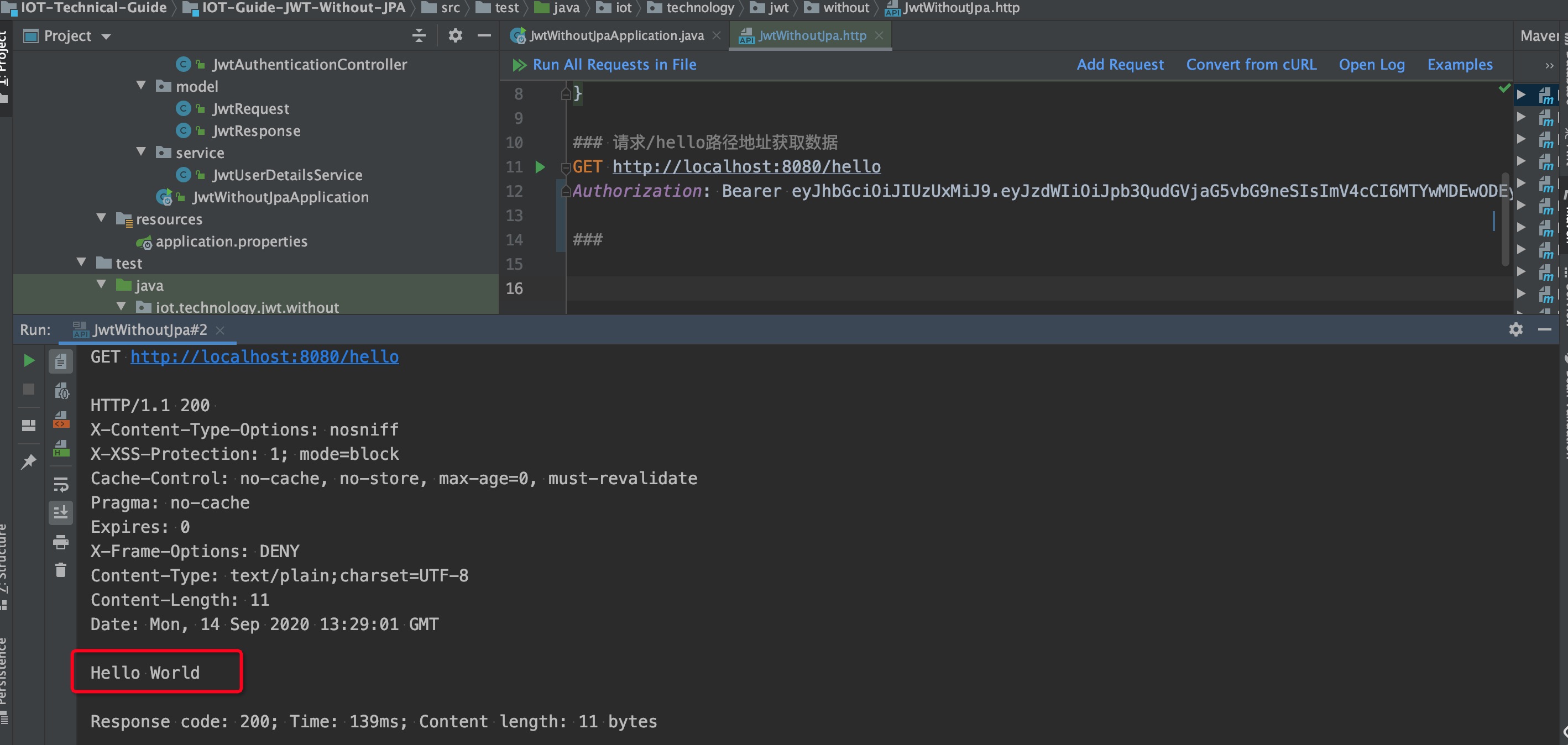
项目源代码:
https://github.com/IoT-Technology/IOT-Technical-Guide/tree/master/IOT-Guide-JWT-Without-JPA
